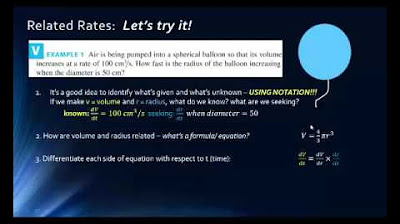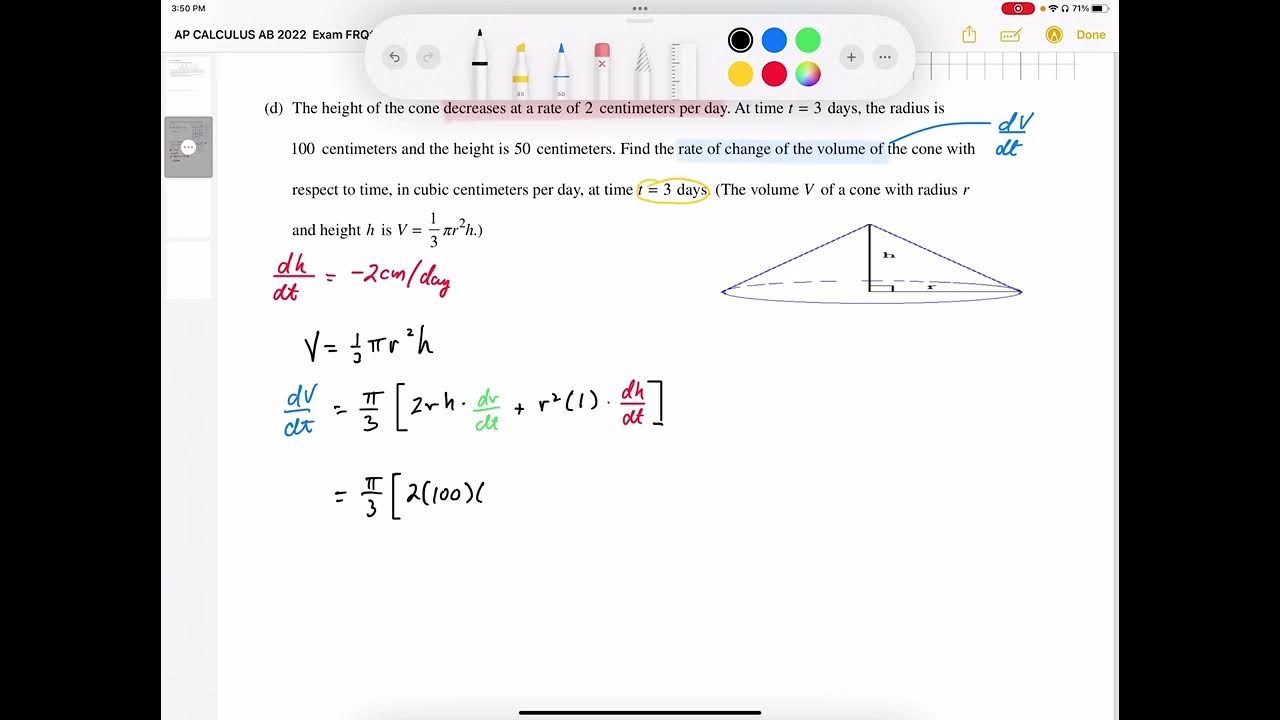Related Rates in Calculus
TLDRThe script discusses using calculus to solve related rates problems, where you know how one quantity in a system is changing and want to determine how a related quantity changes. It provides examples like a growing balloon where volume change over time is known and rate of radius change is sought. Equations relating quantities like volume and radius are differentiated with respect to time. Known values are plugged in and the desired rate of change is solved for. Issues like needing the chain rule are also covered. The key is relating quantities mathematically, differentiating with respect to time, plugging in knowns, and solving for the desired rate of change.
Takeaways
- 😀 Related rates problems involve finding the rate of change of one variable based on known rates of change of related variables
- 😊 We can apply calculus concepts like implicit differentiation to model real-world scenarios involving changing quantities
- 🤔 To set up a related rates problem, we first need equations relating the key variables of interest
- 😟 Taking derivatives with respect to time gives rates of change rather than just static variable relationships
- 🧐 The chain rule is often required when differentiating implicitly defined relationships
- 😎 Once mathematical relationships are established, we plug in known values and solve for the desired rate of change
- 🤓 Examples include modeling expanding volume of a balloon or changing ladder positions over time
- 😳 Careful diagram drawing and variable definitions are key first steps for comprehending and setting up the problem
- 🤯 The most challenging part is formulating the mathematical relationships, taking derivatives is usually straightforward
- 😀 By methodically following steps, these multi-step rate of change problems can be broken down and solved
Q & A
What is the concept of related rates in calculus?
-Related rates refers to determining the rate of change of one variable with respect to another variable that is related to it through some equation or relationship.
How can we find the rate of change of the radius of a sphere if we know the rate of change of its volume?
-We can use the equation relating volume and radius, V = (4/3)πr^3, take the derivative of both sides with respect to time, and solve for dr/dt.
What information is given about the ladder sliding down the wall example?
-The ladder is 10 feet long and is sliding away from the wall at 1 foot per second. We want to know how fast the top is sliding down when the bottom is 6 feet from the wall.
What is the first step in solving a related rates problem?
-Draw a diagram representing the scenario and variables involved. Identify the known and unknown rates of change.
How did we relate the variables x and y in the ladder example?
-We used the Pythagorean theorem, x^2 + y^2 = 10^2, to relate the lengths x and y which change over time.
Why do we take the derivative with respect to time in related rates problems?
-We are interested in determining rates of change, which require derivatives with respect to time.
What was the rate of change of y in the ladder example?
--3/4 feet per second. It is negative because y is decreasing over time as the ladder slides down.
What is the main challenge in solving related rates problems?
-Understanding what the problem is asking, drawing the right diagram, and writing equations relating the variables involved.
When might we need to use the chain rule in related rates problems?
-When taking the derivative of a function with respect to time, if that function depends on another variable that changes with time.
What are the general steps for solving related rates problems?
-1. Draw diagram and identify knowns and unknowns. 2. Write equations relating variables. 3. Differentiate w.r.t. time. 4. Plug in known values. 5. Solve for desired rate of change.
Outlines
🎈 Introducing Related Rates
Paragraph 1 introduces the concept of related rates, which involves calculating how one quantity is changing in relation to another changing quantity. It provides an example of inflating a balloon, where the volume is increasing at a measurable rate, and we want to determine how fast the radius is increasing using calculus.
📏 Applying Related Rates to a Ladder Problem
Paragraph 2 applies related rates to a practical example involving a ladder sliding down a wall. It explains the steps of drawing a diagram, writing equations relating the variables, taking derivatives, and plugging in known values to solve for the unknown rate of change.
Mindmap
Keywords
💡related rates
💡implicit differentiation
💡chain rule
💡rate of change
💡Pythagorean theorem
💡diagram
💡functions of time
💡parameters
💡right triangle
💡equations
Highlights
The study found a significant increase in life satisfaction for participants who engaged in acts of kindness.
Volunteering and community service can provide a sense of purpose and fulfillment for older adults.
Social isolation was identified as a major risk factor for cognitive decline in seniors.
Regular physical activity can help maintain cognitive function and delay the onset of dementia.
Creative activities like art, music, and dance can stimulate the brain and enhance well-being in later life.
Reminiscence therapy utilizing photos, music, and shared memories was found to improve mood for dementia patients.
Intergenerational programs can provide social connection and counteract ageism in society.
Assistive technologies like medication reminders and fall detectors can support independent living.
Healthy diet and nutrition are critical for maintaining cognitive health into old age.
Hearing loss interventions like hearing aids can improve communication and reduce isolation.
Pets can provide companionship and stress relief for older adults living alone.
Multicomponent physical activity programs show promise for fall prevention in seniors.
Cognitive training exercises may help older adults maintain focus, memory and problem solving skills.
Addressing transportation barriers is key for enabling access to healthcare and community services.
Continuing education programs help older adults stay mentally, socially and physically active.
Transcripts
5.0 / 5 (0 votes)
Thanks for rating:





